*For Windows 7, click here*
1) Elipse DCOM Wizard
Elipse DCOM Wizard is a wizard to configure DCOM (Distributed Component Object Model) and Windows Firewall to allow remote connections. It displays predefined settings for the main products by Elipse Software, but it can be also used to configure third-party products. By running the wizard, the settings described below are applied automatically.
Elipse DCOM Wizard Download.
2) Introduction
Anxiously awaited by Windows XP users, the Service Pack 2 has brought a series of updates and improvements to this operational system, mainly in the area of data security. One of the most important new features was the presence of a software firewall, which is now an intrinsic part of the operating system itself.
Firewalls are barriers interposed between a private network and an external network, in order to prevent attacks or invasions. That is, they are security mechanisms (devices) that protect the company’s hardware and software from the dangers to which the system is exposed. These security mechanisms are both hardware- and software-based, and follow the security policy established by the company.
In addition this new feature, COM and DCOM models also underwent changes. Microsoft’s COM (Component Object Model) is a distributed, platform-independent, object-oriented system for creating binary software components that can interact with each other. DCOM (Distributed Component Object Model) allows applications to be distributed to the most relevant sites for the user and for the application. DCOM connection protocol offers transparent support, for a reliable and efficient communication between COM components. For this reason, this is the protocol used in OPC drivers.
In order to have the Elipse systems functioning properly, you will need to make some adjustments in the settings of Firewall and DCOM, as discussed below. These settings must be performed both in the server and in the client machines, regardless of how communication takes place (either between Elipse modules or between OPC client and server).
3) Firewall
In the first initialization after Service Pack 2 had been installed, a wizard asks you if you want to either activate the Firewall or to let it remain disabled. After this, a new shortcut is available on the control panel, called Windows Firewall (Fig. 1).
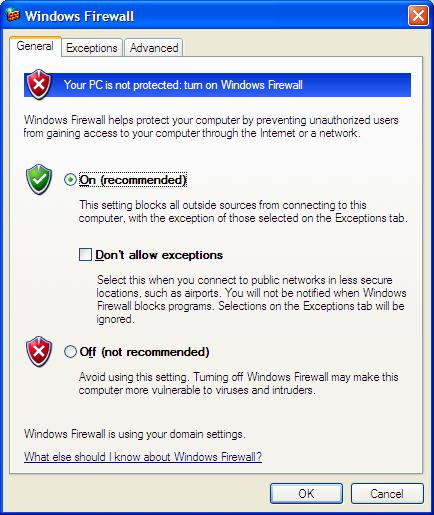
Figure 1 – Activating the firewall
If you choose to disable the Firewall, no further action is required to operate the OPC Server or any other feature of Elipse products (notice however that it will still be necessary to follow the instructions contained in the DCOM session). In case you need to activate the firewall, a few other steps must be followed. First of all, the option Don’t allow exceptions MUST be unchecked. Otherwise, all exceptions will be ignored, and DCOM (the object of this article) will not be able to operate on the network. Once this precaution is taken, it will be necessary to inform some exceptions in the tab Exceptions (Fig. 2).

Figure 2 – Including exceptions
Basically, you should add E3Server.exe, E3OPCClient.exe, E3Run.exe, and Studio.exe for E3, or Elipse32.exe for Elipse SCADA. For Elipse OPC Drivers, add ED_OPC.exe. In Windows Vista, you must also add Opcenum.exe, found at C:Windowssystem32 (in 32-bit Windows) or C:WindowsSysWOW64 (in 64-bit Windows), which will enable remote connection with OPC clients.
In addition to these programs, you must also create new input rules to allow ports 135 (TCP and UDP) and 445 (TCP), used by DCOM, and 6515 (TCP), responsible for connecting the Viewer to E3Server and Hot-Standby, and also for connecting the Studio to a remote E3Server.
Once it is done, the application is ready to work with the Firewall.
4) DCOM
Some Windows XP and Windows 2003 Server users for stand-alone and domestic applications have sometimes wondered if DCOM is really useful for their daily tasks. However, SCADA applications cannot dispense with this functionality. Changes were made at DCOM to get around security failures that were made evident with the proliferation of worm and virus attacks based on this communication protocol, without damaging applications that effectively need DCOM. An example of DCOM evolution in Service Pack 2 is that, unlike older versions of COM server application, DCOM allows restricting the application so that it can only be used locally without being exposed on the network via DCOM. When users have access to a COM server application, they have access to both local and remote use.
For that matter, a few measures must be taken so that the application continues working as it has before: to configure this option from the user interface, the administrator must open the Component Services Manager (DCOMCNFG) and select Properties from the context menu of the computer being set (Fig. 3).

Figure 3 – Selecting the computer to be configured
A dialog box will be displayed (Fig. 4), and security must be configured on COM Security tab.

Figure 4 – Configuring security
Click Edit Limits… on Access Permissions, add users ANONYMOUS LOGON, Everyone, and SYSTEM, and check the options Local Access and Remote Access for these users (Fig. 5).

Figure 5 – Setting access permissions
Click Edit Limits… on Launch and Activation Permissions, add users ANONYMOUS LOGON and SYSTEM, and check the options Remote Launch and Remote Activation for these users. You must also check these options for user Everyone (Fig. 6).

Figure 6 – Setting launch permissions
You must then grant E3Server‘s access, initialization, and remote activation permissions to ANONYMOUS LOGON user. To do so, right-click E3Server and select Properties on its context menu (Fig. 7).
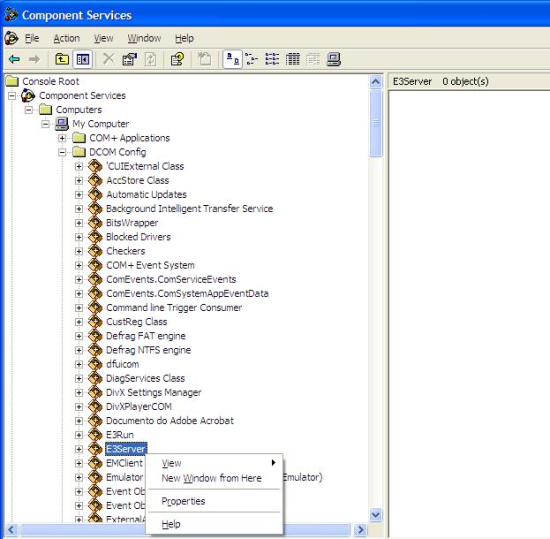
Figure 7 – Selecting E3Server’s properties
Select Security tab (Fig. 8).

Figure 8 – Setting E3Server’s security
Click Edit on Launch and Activation Permissions, add user ANONYMOUS LOGON, and check the options Remote Launch and Remote Activation (Fig. 9).
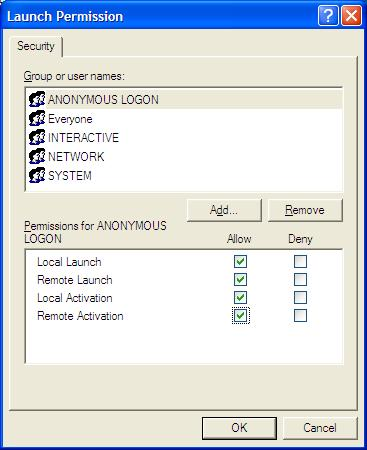
Figure 9 – Setting E3Server’s launch permissions
Click Edit on Access Permissions, add user ANONYMOUS LOGON, and check the option Remote Access (Fig. 10).

Figure 10 – Setting E3Server’s access permissions
After that, you must grant E3Run‘s access, initialization, and remote activation permissions to ANONYMOUS LOGON user. To do so, right-click E3Run and select Properties on its context menu (Fig. 11).
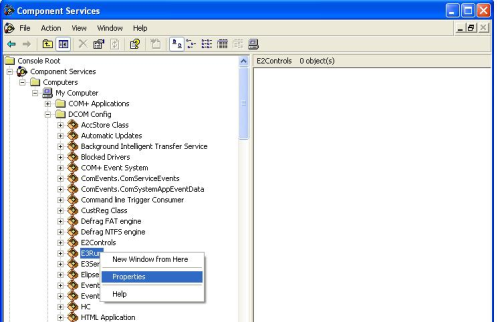
Figure 11 – Selecting E3Run’s properties
Select Security tab (Fig. 12).
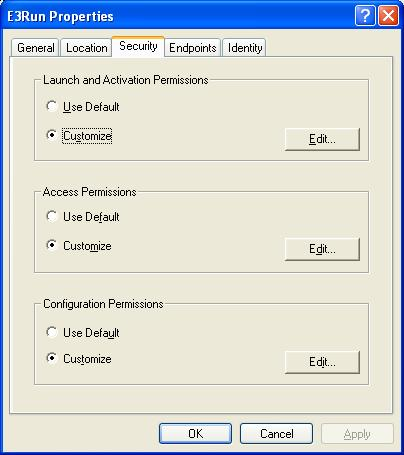
Figure 12 – Setting E3Run’s security
Click Edit on Launch and Activation Permissions, add user ANONYMOUS LOGON, and check the options Remote Launch and Remote Activation (Fig. 13).
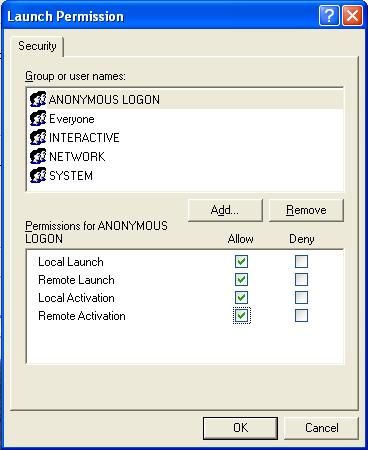
Figure 13 – Setting E3Run’s launch permissions
Click Edit on Access Permissions, add user ANONYMOUS LOGON, and check the option Remote Access (Fig. 14).

Figure 14 – Setting E3Run’s access permissions
Finally, if the application uses OPC, you must also grant OpcEnum‘s access, initialization, and remote activation permissions to ANONYMOUS LOGON user. To do so, right-click OpcEnum and select Properties on its context menu (Fig. 15).

Figure 15 – Selecting OpcEnum’s properties
Select Security tab (Fig. 16).
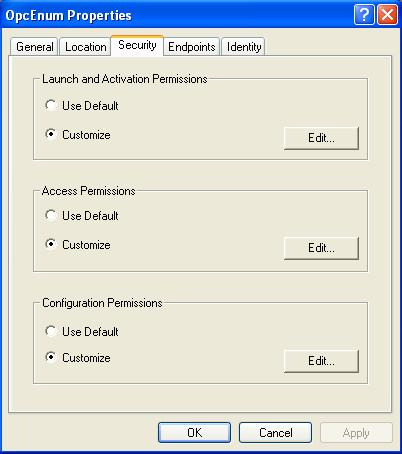
Click Edit on Launch and Activation Permissions, add users ANONYMOUS LOGON and SYSTEM, and check the options Remote Launch and Remote Activation (Fig. 17).
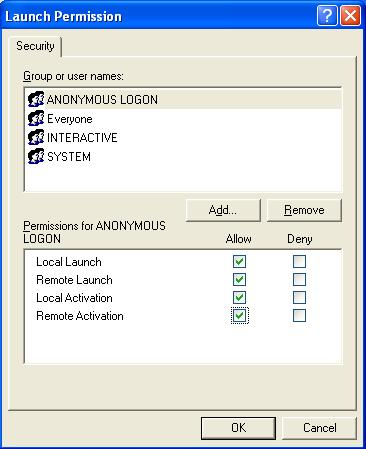
Figure 17 – Setting OpcEnum’s launch permissions
Click Edit on Access Permissions, add users ANONYMOUS LOGON and SYSTEM, and check the option Remote Access (Fig. 18).
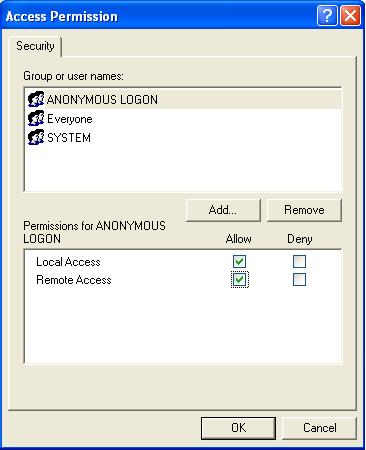
Figure 18 – Setting E3Run’s access permissions
For Elipse E3 versions 4.6 or higher, you will also need to grant permissions for accessing, initializing, and remotely activating E3OPCClient to ANONYMOUS LOGON user.
These changes will make DCOM as Windows XP did before Service Pack 2.
NOTE: It is essential that all computers on the network use the same settings suggested in this article, otherwise they too will refuse the connection to the OPC Server.
5) Network
To establish OPC communication with the settings in this article, all the computers involved must be in the same Microsoft domain, or at least in Work Groups with necessarily the same user and the same password in all computers (the user won’t necessarily need to be logged in, only to have been already created).
All computers in the network must be able to “spot” each other by their names to exchange information; sharing only the IP or a folder won’t be enough for establishing OPC communication.
6) Final Remarks
By better understanding how Windows Firewall (which guarantees extra protection for the computer on the network) and DCOM (an important protocol used by OPC drivers) work, it is possible to design a configuration that makes sure Elipse OPC drivers work the same way as they did in Windows XP’s previous edition.
The changes suggested here do not represent the only alternative to solve the problem in question. For more specific solutions, and even less network exposure, please refer to:
